 The Map of Tsavo
The Map of Tsavo
The infamous tale of rampage narrated here is based on actual facts and true events – the most incredible parts of the story are true and have been documented, as such, in the annals of history. It concerns “The Tsavo Man-Eaters” – a pair of notorious, man-eating lions responsible for the deaths of a large number of construction workers on the Kenya-Uganda Railway, from March 1898 till December 1898.
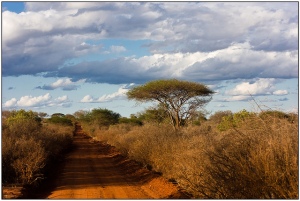 The friendless, rugged landscape of Tsavo.
The friendless, rugged landscape of Tsavo.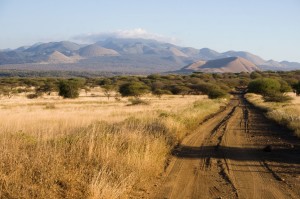 The vast open expanse of the Savannah grasslands.
The vast open expanse of the Savannah grasslands.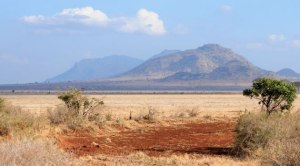 East Tsavo
East Tsavo Tsavo – “a place of slaughter.” Tsavo, in 1898, was considered to be “the worst place on Earth.”
Tsavo – “a place of slaughter.” Tsavo, in 1898, was considered to be “the worst place on Earth.” Legendary Lt. Col. John Henry Patterson.
Legendary Lt. Col. John Henry Patterson. Charles Remington – the great, white hunter and unerring marksman of that time.
Charles Remington – the great, white hunter and unerring marksman of that time.
Tsavo is a region of Kenya, in the African subcontinent, located at the crossing of the Uganda Railway over the Tsavo River. Its name is derived from a Masai word sabuk (pronounced tsavok) which means ‘river.’ The British were responsible for putting an end to the slave trade only in the 19th century; till the advent of such a time, caravans full of Arab slave-owners and their captives, bound for Zanzibar, crossed Tsavo, in droves. Many of the travelers dropped dead by the wayside, (probably from the extremes in the climatic conditions of Tsavo and the possibly massive ill-treatment from their slavers); the rotting corpses of these dead travelers were devoured by lions who, in this way developed a taste for human flesh. An outbreak of cattle plague in 1898 devastated the lions’ usual prey, forcing them to find alternative food sources. “Ritual invitation”, or abbreviated cremation of Hindu railroad workers, invited scavenging by the lions. These are thought widely to be the likely reasons for the vicious attacks, on human beings, by the two, infamous Tsavo Man-Eaters.
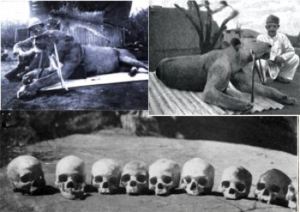 The Tsavo Man-Eaters – one of the worst cases of man-eaters recorded.
The Tsavo Man-Eaters – one of the worst cases of man-eaters recorded. “The Man-eaters of Tsavo” – a book of memoirs concerning Lt. Col. John Henry Patterson’s struggle against the Savage Man-Eaters of Tsavo.
“The Man-eaters of Tsavo” – a book of memoirs concerning Lt. Col. John Henry Patterson’s struggle against the Savage Man-Eaters of Tsavo.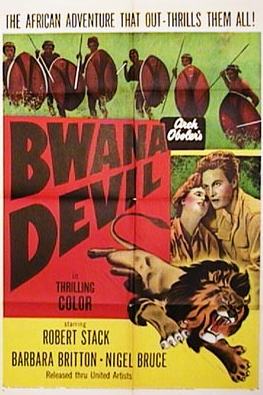 “Bwana Devil” – the poster of the 1952 film.
“Bwana Devil” – the poster of the 1952 film.
In contemporary times, two Kenyan national parks, Tsavo East National Park and Tsavo West National Park are located nearby – they form locations for popular, touristic safaris in a region that is composed of varied, spectacular landscapes and abundant wildlife. The vast open Savannah landscape consists of fields-upon- fields of dense grasslands – the grass here has the capacity of growing to a height of 3 meters. In 1898, when these events occurred, the native Africans themselves called Tsavo, “the worst place on Earth” and “a place of slaughter.” To be forced to work in Tsavo, as a means of one’s livelihood, at such a time, was considered to be the worst punishment possible – equivalent to being forcibly deputed to the icy, freezing and windy wastelands of Siberia. In Tsavo, the breeze whistled eerily through the tall, swaying grass; the wind howled creepily like the hissing breath of the ghosts of long-dead, tormented souls and the grass hid in its deadly depths, the shadows of lurking man-eating lions, lusting for yet another taste of human flesh and blood. An air of general unease, punctuated by the menacing, low growls of preying lions and the scent of imminent terror had long ago seeped into the pores of this tainted region. It was a region of torture and death overseen by the Devil himself – make absolutely no mistake about that. If anyone were to speak of ‘The Most God-Forsaken place on Earth’ – it would undoubtedly be Tsavo, as it was, in 1898.
 The film poster from 1996 entitled, “The Ghost and The Darkness” starring Val Kilmer and Michael Douglas.
The film poster from 1996 entitled, “The Ghost and The Darkness” starring Val Kilmer and Michael Douglas. The Infamous Tsavo Man-Eaters – displayed prominently in The Field Museum of Natural History, Chicago, Illinois.
The Infamous Tsavo Man-Eaters – displayed prominently in The Field Museum of Natural History, Chicago, Illinois. Fear as an Emotion
Fear as an Emotion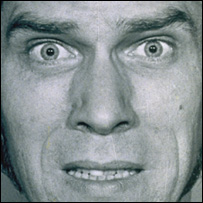 The Look of Fear
The Look of Fear Phobias are extremes of irrational fear.
Phobias are extremes of irrational fear. The Fight or Flight Response.
The Fight or Flight Response. Fear is what keeps the soldiers who are at war alert and alive.
Fear is what keeps the soldiers who are at war alert and alive. The World of Adventure and Extreme Sports.
The World of Adventure and Extreme Sports.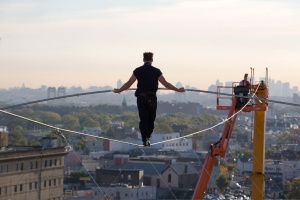 A Tightrope Walker usually has no safety net below him to cushion his fall. Is he afraid? Yes, of course!
A Tightrope Walker usually has no safety net below him to cushion his fall. Is he afraid? Yes, of course!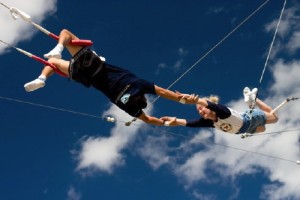 Professional trapeze artists have no safety net below them to break their fall. Yes, they are fearful!
Professional trapeze artists have no safety net below them to break their fall. Yes, they are fearful!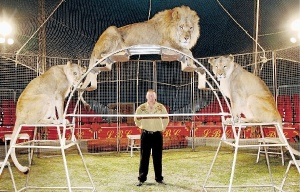 The Circus Lion Tamer perpetually fears an attack from the lions that he thinks he has “tamed.”
The Circus Lion Tamer perpetually fears an attack from the lions that he thinks he has “tamed.”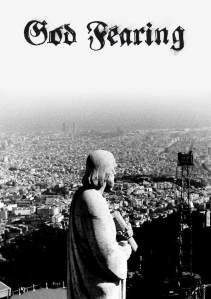 The act of being God-fearing makes you a better person in the long run – it makes you humble and respectful.
The act of being God-fearing makes you a better person in the long run – it makes you humble and respectful. Learn to Fear God – He is the All-Powerful Supreme Being. He created the Universe in His Infinite Wisdom.
Learn to Fear God – He is the All-Powerful Supreme Being. He created the Universe in His Infinite Wisdom.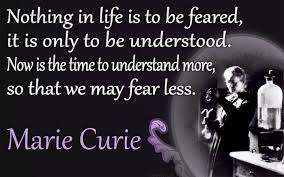 Marie Curie’s quote on Fear.
Marie Curie’s quote on Fear. Learn to be God-Fearing – it will make you a much better person in the long run. Fear is what makes you humble and respectful towards others.
Learn to be God-Fearing – it will make you a much better person in the long run. Fear is what makes you humble and respectful towards others. “God Moves in Mysterious Ways; His Wonders To Perform” – have Faith in Him even if His ways cannot always be understood.
“God Moves in Mysterious Ways; His Wonders To Perform” – have Faith in Him even if His ways cannot always be understood.
During the next nine months of construction, two mane-less, male, Tsavo lions stalked the campsite, dragging screaming and fearful Indian workers from their tents at night and devoured them – with nothing less than relish and greed. The man-eaters “owned the night” but they hunted their prey, surprisingly, in the daylight hours too. After losing dozens of workers to the rampaging lions, the railroad company brought in Charles Remington, an American ‘great white hunter’, to kill them, but even his reputation for being the best marksman could not prevent yet more carnage and untold, grisly mauling and slaughter of innocent victims. It is believed that about 135 victims were killed by the two lions, in the span of just a few months. Crews tried to scare off the lions by building campfires and bomas of thorn fences around their camp for protection and to keep the man-eaters out but to no avail; the lions crawled through the thorn fences. After the new attacks, hundreds of workers rebelled and fled from Tsavo, halting construction on the bridge. Patterson set up traps and tried several times to ambush the lions at night from a tree – from a hunting contraption, of Indian origin, consisting of two, very tall, wooden stilts, with a seating platform on it top for the hunter, called a “machaan.” However, this method of hunting failed miserably too. The story unfolded with such intense fury and so savagely that it soon became amply obvious that the lions were relentlessly stalking the hunters rather than the situation being reversed. The hunters had become the hunted and the prey of these savage beasts. The race for survival of Man against the raging, man-eating beasts became more and more intense, with the passage of each day.
In March 1898, the British started building a railway bridge over the Tsavo River in Kenya. This project was led by Lt. Col. John Henry Patterson – a civil engineer and a skilled, sharp-shooting hunter himself. Patterson’s ruthless and self-serving British employer, Beaumont was only concerned with the obtainment of a knighthood, from the Queen of England, for himself; he couldn’t care less about the serious, life-threatening problems that Patterson soon began to face, at that time. It started with unrest and discontentment among the railroad laborers – this was an age when the mechanization of fork-lifts, pulleys and cranes was largely unknown. It so happened that the African laborers could not get along amicably with the Indian Hindu workers and the Indians themselves had their differences of opinion with their own fellow-Indian compatriots. The hard, manual labor of thousands of laborers was needed for this awesome task of construction – a task, set against tremendous odds; a task that needed to be compulsorily completed by the British task-force, within a set deadline because they needed to overtake the Germans and the French who were not far behind in the Race of Imperialism. The rugged territory of Tsavo was totally friendless; not to mention the difficult and extreme climatic conditions. The only thing that Patterson had in his favor, for such an impossible mission, was his genuine love for Africa.
The incredible tale of gory rampage that ensued made the locals name these two man-eaters, “The Ghost and ‘The Darkness.” The story of the Tsavo Man-eaters became a Legend, in its own right. The natives believed them NOT to be Lions at all -they believed that these acts of untold vengeance represented the evil spirits of long-dead medicine-men – reincarnated as vicious, man-eating lions who had returned to Earth to haunt and stalk men, as a punishment for the sins visited on them in the past. What was totally unheard of was the fact that there were a couple of man-eating lions hunting together, as a pair – even though, man-eaters are widely known to be lone hunters. It was soon established that these lions were slaughtering people for the sheer pleasure of the kill, like veritable sadists. Patterson and Remington were shocked, beyond belief, when they fell upon the heaped skeletons of several of their devoured victims in the dark, forbidding cave, in the mountains, that formed the well-hidden lair of these lions.
Remington had rightly pointed out to Patterson that these two lions are like a pair of cowardly bullies that are lethal when paired together, as a team – to break their unified might, it was imperative that one of them be killed very soon, in the near future. It would leave the other lion alone and afraid for the very first time in his wretched life –a lion who is just another spineless bully – a lion who would be forced to face the combined wrath of the hunters, on his own. The tables would thus be effectively turned against the maneating, preying lion. In this way, the hunters could, at long last, cheat the second, lone lion and be in a better position to kill it. Such was the plan……
After repeated, unsuccessful endeavors at a kill, Patterson finally managed to shoot the first lion on December 9, 1898. Twenty days later, the second lion was found and killed. The first lion killed measured nine feet, eight inches (3 meters) from nose to tip of tail. It took eight men to carry the carcass back to camp. The construction crew returned and completed the bridge in February 1899. The exact number of people killed by the lions is unclear. Patterson gave several figures, overall claiming that there were 135 victims.
After 25 years, as Patterson’s floor rugs and prized trophies, these man-eating lions’ skins were sold to the Field Museum of Natural History in Chicago, Illinois in 1924 for a sum of US$5,000 (US $66,389.37 in 2012). The lions’ skins arrived at the museum in very poor condition. The lions were then reconstructed and are now on permanent display along with their original skulls.
Patterson’s accounts were published later in his 1907 book entitled, “The Man-Eaters of Tsavo.”
According to Wikipedia (the free encyclopedia), the true story of the Man-Eaters of Tsavo has been the inspiration for a novel concerning them; at least three movies have been produced and are based on the savage rampage of these man-eaters and the lions’ names appear in a particular video game, as shown below:
Patterson’s book was the basis for the movies Bwana Devil in 1952 and The Ghost and the Darkness in 1996, with the incidents also used in 1959’s Killers of Kilimanjaro. The names “The Ghost” and “The Darkness” were names given to the two man-eating lions.
The story of Patterson and the man-eating lions was also an inspiration for the book Three Weeks in December by Audrey Schulman, published in 2012.
The lions also appear as a difficulty to be overcome in the “Cape to Cairo” scenario of the video game Railroad Tycoon II.
The plot of the Willard Price book Lion Adventure was inspired by the man-eaters of Tsavo, where Hal and Roger Hunt are hired to deal with a man eating lion that’s preying on rail road workers. At one point in the book, Hal recounts the original tale of Colonel Patterson.
————————————————————–
FEAR is an unpleasant feeling of perceived risk or danger, whether real or not. Fear can also be described as a feeling of extreme dislike to some conditions/objects, such as: the fear of darkness, the fear of ghosts, the fear of closed spaces, etc. It is one of the basic emotions. Intense and chronic fear leads to the occurrence of varied PHOBIAS. A phobia is defined as being an extreme or irrational fear of or aversion to something: such as -“she had a phobia of drowning”; “a phobia of germs,” etc. Fear inside a person has different degrees of expression and varies from one person to another. If not properly handled, fear can lead to social problems. People who experience intense fear have been known to commit irrational and/or dangerous acts.
Related articles
- Book Trailer: In the Shadow of the Lion by Kimberly M. Jane (iamkellibeck.com)
- Man Knowledge: A History of Man-Eaters (artofmanliness.com)
- Why go on a Kenya Safari? (theearthsafari.wordpress.com)
- KWS wardens arrest 12 over lion’s killing (businessdailyafrica.com)
- A Return Visit to Kenya: Part 3 – Kitani Camp, West Tsavo (expandyourlimits.wordpress.com)
- A Return Visit to Kenya: Part 5 – Ol Tukai Camp, Amboseli (expandyourlimits.wordpress.com)
- A History of Man-Eaters (neatorama.com)
- Kenya Wildlife Service Searches for Black Rhino (ugandasafaris.typepad.com)
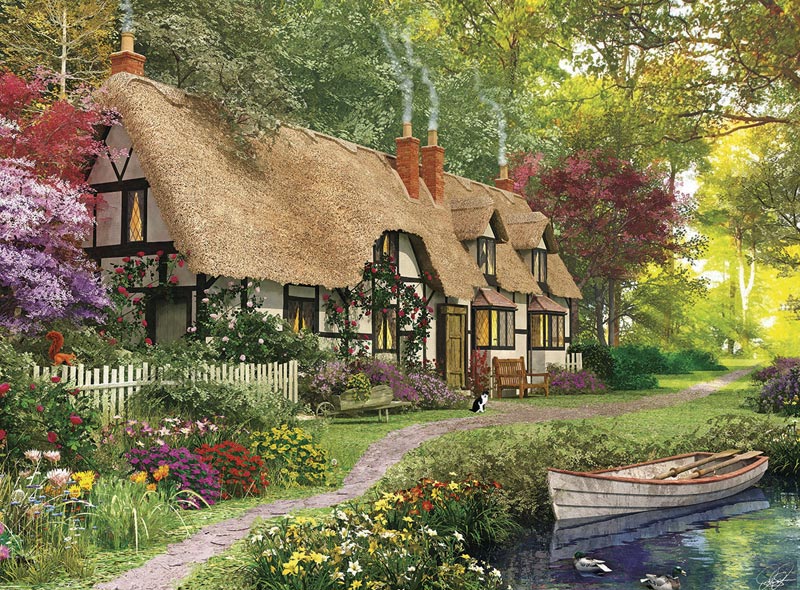

The info on this site is not the true story of the Tsavo Maneating Lions. For instance, there was never a hunter named Remington who came to help Patterson.
LikeLike
Thank you, Wanda, for your astute observation. This blog is indeed based on the film of the same name. I have added a post-script at the end of the blog to this effect, so that it does not mislead my readers. Thanks again and do keep in touch!
LikeLike
You have related the events of the film as if they are all factual. A little research would have revealed that Charles Remington is a completely fictional character. Recent research, taking into account the caloric budget of an adult male lion and the chemical and isotopic analysis of the skins suggests a probable consumption of 10 humans for one of the lions and 24 for the other. The 135 figure is far outside any reasonable range, and without evidential support.
LikeLike
Thank you, Mr. Thomas, for your astute observation. This blog is indeed based on the film of the same name. I have added a post-script at the end of the blog to this effect, so that it does not mislead my readers. Thanks again and do keep in touch!
LikeLike
For the first sixteen years of my life I lived with fear as a constant companion. In life there are many things to logically fear such as, fear of heights, fear of drowning, fear of the unknown and so on. What you don’t expect to have to worry about or fear is a parents lack of love or lack of self control. That was a fear that became a reality for my mother, myself, my sister, and my two younger brothers. Our fear was not based on imaginary things that go bump in the night, but, on a real monster that we called our dad. He was prone to giving out beatings without warning and using torture as a form of discipline. We have carried the scars of our childhood with us well into our adult life. Even though he has been dead 15 years now, He still haunts my dreams. There are many children out there who are currently living this same kind of nightmare. unless we as a society make a concerted effort to reach out to help these children we will continue to lose generations of our future. Stronger laws need to be made to protect our children while at the same time giving out stiffer prison sentences to those who commit the worst types of child abuse.
LikeLike